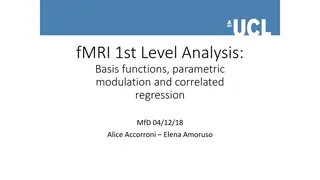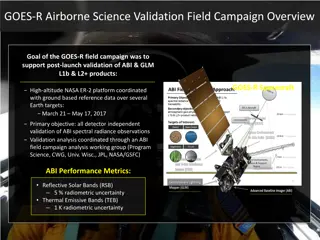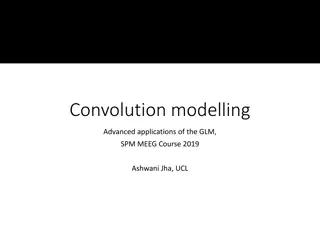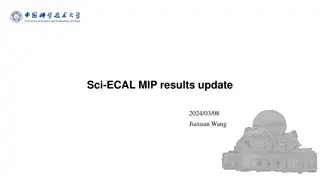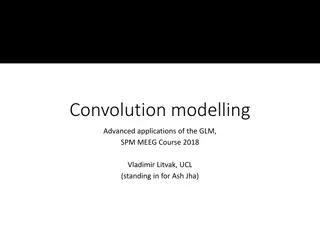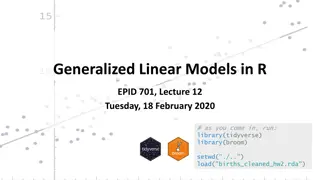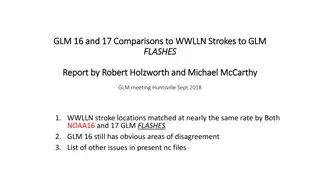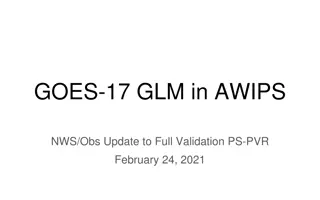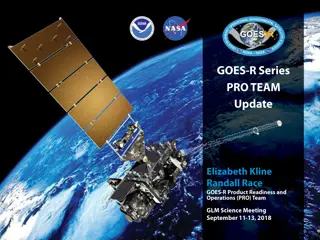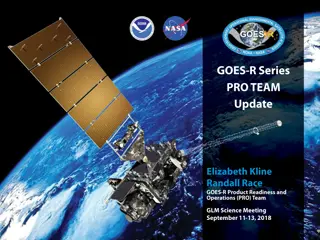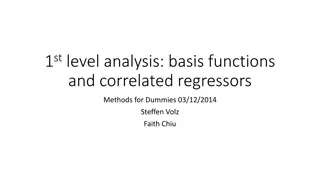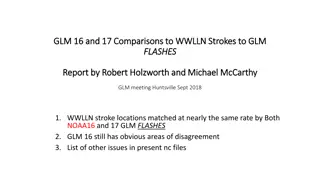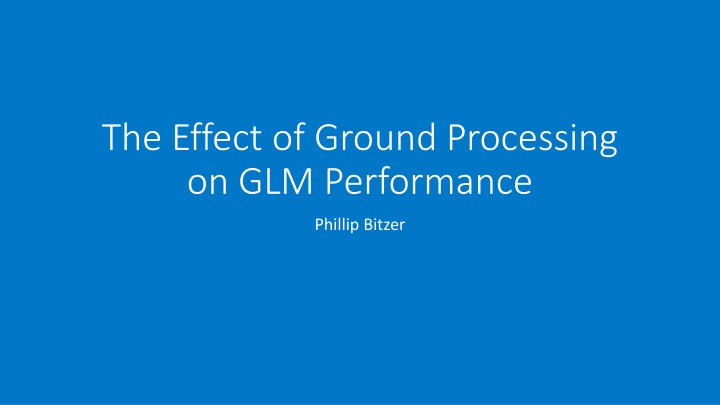
Enhancing GLM Performance Through Ground Processing: Insights & Results
Delve into the impact of ground processing on GLM performance with insights on factors affecting detection efficiency, assessment methods, and comparison of results. Explore previous findings and new results from the Relampago campaign in Argentina, shedding light on storm characteristics and detection rates. Dive into specific case studies, such as the high flash rate storm on December 14, 2018, showcasing detection rates and methodologies used. Discover how ground algorithms and instrument performance influence the detection of lightning flashes.
Download Presentation

Please find below an Image/Link to download the presentation.
The content on the website is provided AS IS for your information and personal use only. It may not be sold, licensed, or shared on other websites without obtaining consent from the author. If you encounter any issues during the download, it is possible that the publisher has removed the file from their server.
You are allowed to download the files provided on this website for personal or commercial use, subject to the condition that they are used lawfully. All files are the property of their respective owners.
The content on the website is provided AS IS for your information and personal use only. It may not be sold, licensed, or shared on other websites without obtaining consent from the author.
E N D
Presentation Transcript
The Effect of Ground Processing on GLM Performance Phillip Bitzer
What goes into GLM detection efficiency? GLM performance, i.e., detection efficiency, is determined by two factors: Instrument performance how well does GLM detect light Ground algorithms how well does ground processing filter noise from lightning Each contribute to what the user cares about how much lightning is detected. But can we improve what we have?
How do we assess performance? To assess how GLM is performing, we find GLM events that occur within the spatial-temporal bounds of a LMA flash Eliminates any ambiguities caused by flash grouping Run matching on both L1b and L0 L0 represents best possible performance with instrument (as currently configured) L1b represents combined instrument + ground algorithm Comparison of L1b and L0 yields the effect of ground processing
Previous Results We ve reported DE using this technique before, mostly using PLT results Consistent with other researchers, DE varies as a function of flash area and storm mode/type But certain storm type/mode also yields low(er) DE for ground based systems LMA Area (km2) DE (GLM | NALMA) DE (GLM | COLMA) DE (ENI | COLMA) All 0.617 0.256 0.372 > 8 0.738 0.365 0.534 > 16 > 32 0.806 0.873 0.429 0.522 0.609 0.702 > 64 0.922 0.649 0.797 > 100 0.947 0.746 0.850
New Results Now, we ll look at a couple of cases from the Relampago campaign in Argentina, including an anomalous storm This gives results for storms post-PLT tuning, in addition to a slightly less off-axis viewing angle
20181214 High Flash Rate Storm Dec 14, 2018 00Z-09Z MCS with max flash rate ~ 600/min and overshooting tops Almost 22 000 flashes detected LMA source altitude mode at approximately 10 km Analyzed in Lang et al. 2020
20181214 High Flash Rate Storm Area (km2) Num LMA Flashes Num GLM L1b DE L1b Num GLM L0 DE L0 All 20822 8222 0.395 12285 0.590 > 8 > 16 12651 6953 0.550 9494 0.751 8426 5472 0.649 6972 0.827 > 32 4918 3809 0.775 4485 0.912 > 64 > 100 2477 2185 0.882 2397 0.968 1414 1324 0.936 1399 0.989 Operational algorithm yields an overall DE of 40%, yet almost 60% of the flashes were detected by the instrument Consistent with previous results, DE improves (significantly) with increasing flash size.
20181214 High Flash Rate Storm L0 detects more flashes during times when L1b struggles
20181214 High Flash Rate Storm While there is a dependence of DE on flash area and altitude, it is not linear. Very little light is detected for small flashes at all altitudes.
20181220 Anomalous Storm Dec 20, 2018 17Z-2359Z Anomalous charged storm (likely) with max flash rate ~ 250/min Almost 140 000 flashes detected LMA source altitude mode at 4-8 km Analyzed in Lang et al., 2020
20181220 Anomalous Storm Area (km2) Num LMA Flashes Num GLM L1b DE L1b Num GLM L0 DE L0 All 135956 62897 0.463 87888 0.646 > 8 > 16 69687 46506 0.667 57190 0.821 43893 32775 0.747 38191 0.870 > 32 > 64 > 100 24274 19961 0.822 22192 0.914 11940 10494 0.879 11304 0.947 7133 6430 0.901 6840 0.959 Again, there is almost a 20 percentage point improvement in DE! There are decreasing gains with increasing area.
20181220 Anomalous Storm L0 detects more flashes during times when L1b struggles
20181220 Anomalous Storm While there is a dependence of DE on flash area and altitude, it is not linear. Very little light is detected for small flashes at all altitudes.
Loss Fraction: 1- DE (L0)/DE (L1) Another way to thing about it is: how much performance is thrown out by ground processing? Area (km2) DE L0 DE L1b Delta DE Loss Fraction All 0.637 0.451 0.186 0.292 < 8 < 16 0.807 0.645 0.162 0.200 0.861 0.728 0.133 0.155 < 32 0.912 0.812 0.101 0.110 < 64 < 100 0.950 0.964 0.878 0.907 0.071 0.057 0.075 0.059 Almost 30% of flashes are filtered by ground processing!
L1b Does duration of the flash matter? The L0 detections are slightly better at short duration flashes but the biggest improvement is among 100-500 ms flashes. Note the L1b result is slightly different from Zhang and Cummins (2020), which showed a monotonic increase of DE with flash size. Begs the question: is L0 just picking up single event flashes? L0
Does L0 matching pick up noise? Although unlikely, an event during the time of a flash, an event in the spatial footprint of the flash could be due to noise. However, the distribution of events per flash doesn t change appreciably. Since we re detecting more smaller/shorter flashes, some shift to fewer events/flash is expected But since the distribution is largely similar, the L0 detections are not just single events detected during longer flashes!
Ground processing affects DE! Current ground processing throws out almost 30% of flashes that the GLM instrument detects. If the detected light during these flashes were correctly (not) filtered, then it leads to a nearly 20 percentage point improvement in detection efficiency. The largest gains are realized with small flashes. The distribution of events per flash does not change appreciably. Also to note: On average, L0 detects flashes about 30 ms earlier that L1b (median: 5 ms).
The next steps So, if the GLM instrument is detecting light during flashes, but current ground processing are not classifying it correctly, then there is an opportunity to improve the end product. Current testing of a new operational-type algorithm (i.e., satisfying ordering and latency requirements) shows at least a few percentage points improvement even in these difficult storms Anomalous storm 39% -> 45% overall Note: current iteration is unoptimized - more improvements to be realized! See Clem s talk Thursday!


